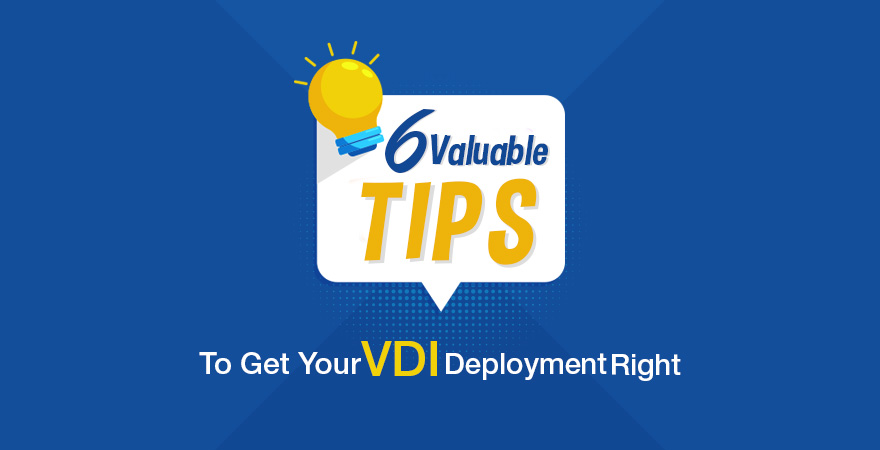A Virtual Desktop Infrastructure or VDI is the next best thing to the Public Cloud. In many deployment scenarios, the unique circumstances of an enterprise do not permit the use of public cloud, no matter how cost effective and convenient that may be.

On the other end of the spectrum is a highly distributed architecture in which data is dispersed sporadically across hundreds or maybe thousands of end point devices in a hap hazard and complex manner. This model gives rise to many administrative and infrastructure management challenges.
Also Read:
- What is Virtual Desktop Infrastructure?
- Why is dinCloud the best VDI solution?
- Virtual Desktop Infrastructure (VDI) Providers
To begin with, you need heavy investment in end point devices as you would want them to have the best specs to extract more performance. Secondly, you would need an army of I.T personnel with a wide range of skills to manage this dispersed infrastructure effectively.
Lastly, the biggest challenge to this model is data security. With data dispersed across so many devices, it is nearly impossible to fully secure each and every end point device individually. Then there is the administrative challenge of updating and patching so many devices, one at a time.
How Does VDI Work?
Before we outline the characteristics of a well deployed Virtual Desktop Infrastructure (VDI) let’s briefly touch how this deployment model works. VDI or private cloud is a centralized deployment model for storage, compute and processing.

In VDI, instances of virtual desktops are created over an exclusive data center that is maintained mostly on premise, along with all the support hardware. The employees or end users of these virtual desktops (VD) would log into their respective device over a secure and dedicated network.
Users can utilize a host of devices to log into their VDs such as smartphone, tablet, laptop or desktop. Each user will log into the VD through unique login credentials. Login in generally a two tier process in which the user will first establish a connection with the company’s network and then login.
All the work that is executed by end users over their respective VDs is stored safely over the centralized data center instead of the end point devices. Like any other cloud deployment model, VDI also has its own set of pros and cons, which we will cover very briefly.
Pros of VDI
- The exclusivity of VDI results in very high performance.
- Each entity can mold the solution as per its unique needs.
- Maximum control over business critical and sensitive data.
VDI Cons
- Huge upfront cost of setting up on premise data center.
- Administrative and operating costs are higher as compared to public cloud.
- There are limitations to scaling, especially when increasing the VDI footprint.
How to Deploy VDI Effectively
Now that we have covered the VDI in some detail, let’s discuss briefly some key factors to consider when deploying a VDI.
Also Read:
- Public v/s Private Cloud for Enterprises
- How to Chalk Out and Implement a Digital Workplace Strategy?
- 10 Factors to Consider Before Migrating to the Hybrid Cloud
Forecast User Requirements
This is a key component of VDI planning phase. Each entity will have to carefully determine its current storage, compute and processing needs as well as demand in the near future. The feasibility of supporting applications and how they would blend in the VDI is critical to success.
Network Design
One of the most compelling reasons for selecting VDI is exclusivity, but this should not come at the price of sub par performance. So, the performance of any VDI environment will hinge around effective network design, in terms of both performance and security.
Forecasting Storage
In a VDI solution, all the storage needs of the deploying entity will have to be met in house and at a centralized data center. It is crucial to thoughtfully plan the existing and future storage needs of the deploying entity. In addition to size, the type of storage solution will also be a key factor.
Persistent or Non-Persistent VDs
This will depend much on the needs of each deploying entity. In persistent VDs, the individual preferences of each end user are individually maintained and served upon next login. While this will greatly enhance user experience, it will add to both the cost and complexity of the solution.
VDI Login Platforms
This factor will influence both the cost of your VDI solution and the end user experience. Each entity will have to determine the device platforms that the VDs would support. As you expand the range of supported device and OS platforms, the complexity of your VDI solution will increase.
Another dimension of this issue is whether to use a Bring Your Own Device (BYOD) model or install low spec systems on premise that are called thin clients. While adding thin clients to the mix will bring a certain degree of uniformity to your VDI solution, it will also result in additional costs.
Availability of VDIs
This facet of the VDI will also have to be dealt with proper planning and forecasting. The organizational performance will heavily rely on the perpetual availability of VDs in even the most challenging circumstances. This will demand full VDI uptime, at least for the business critical processes.
Conclusion
A VDI solution, despite the higher costs, has the potential to serve the computing and processing needs of many different organizations. However, a VDI deployment will demand careful and thoughtful planning that takes into account both the existing and future needs of an enterprise.


